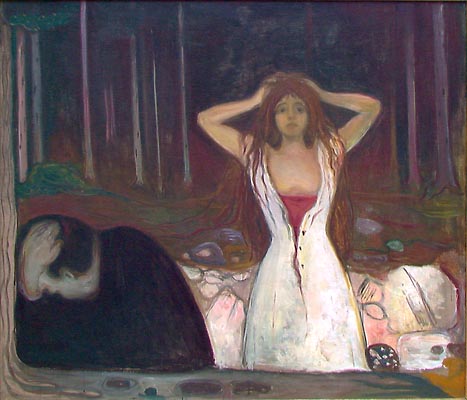
A dark, impenetrable forest forms the backdrop to this cheerless scene.
Ashes - their love is burned out, like the tree-trunk in the foreground
from which smoke rises along the left edge of the painting. The woman
stands on stony ground, holding her head and staring blankly in front
of her with a mask-like expression. The unbuttoned petticoat speaks for
itself as to what went on in the sombre forest. The woman's long hair
streams towards the man, and like tentacles twines about his head and
shoulders. He turns away from her and sits crestfallen, hand on head in
a gesture of despair or grief. After their intimacy, there is no longer
any contact between them. Both are left in a world of loneliness. One
of Munch's most pessimistic paintings of the 1890s, this work says a lot
about his complicated attitude towards women and towards the relationship
between man and woman. Talking about a similar picture, Munch once explained,
"Woman there is at one and same time saint - whore - and wretched in her
infatuation." A comment typical of its day. In the manner characteristic
of Synthetism, the forms in the composition are large areas with fluid
outlines, and all details have been pared away. The colours acquire symbolic
value, the man's black suit contrasting with the woman's petticoat and
the red bodice next to her skin. Form and colour emphasise the symbolic
content of the work. This is no realistic depiction of a romantic stroll
in the forest. All its elements accentuate the main theme of the picture:
the conflict between man and woman.
This is another painting that's too much... Edvard Munch is too much... Here's a glimpse into his anguish-ridden life: Edvard Munch's Biography.
December 24, 2000